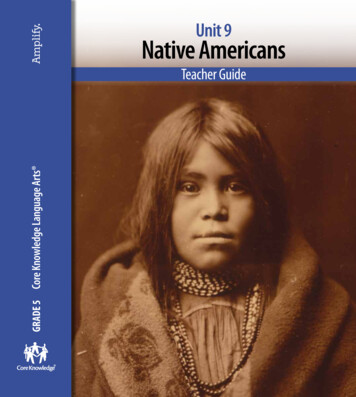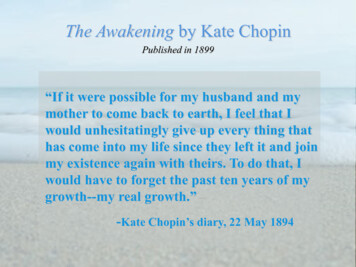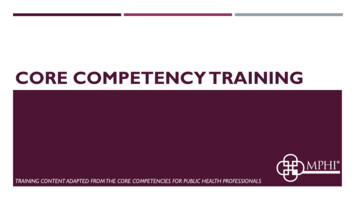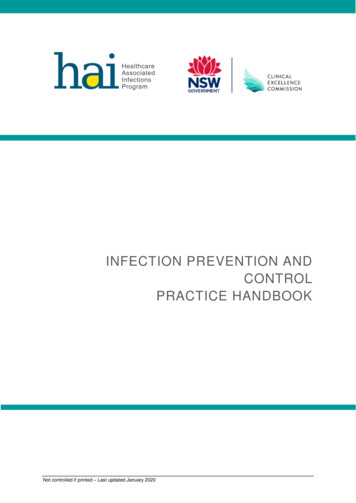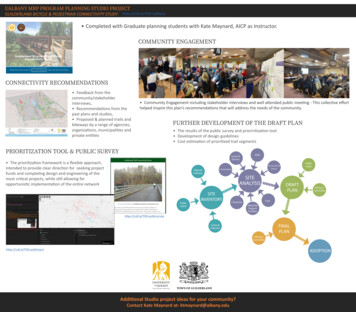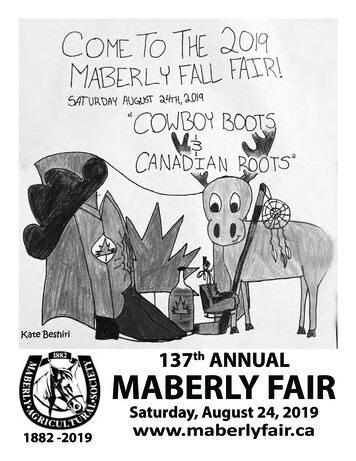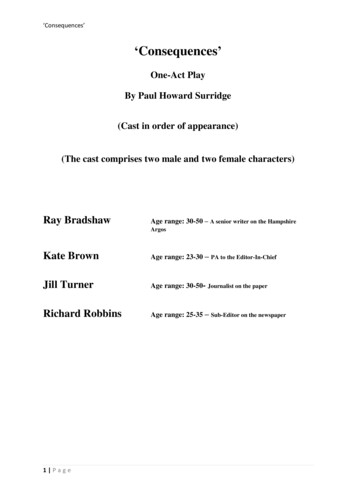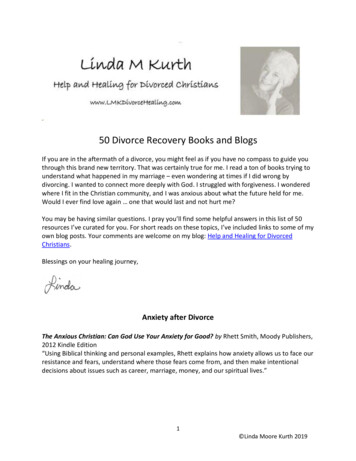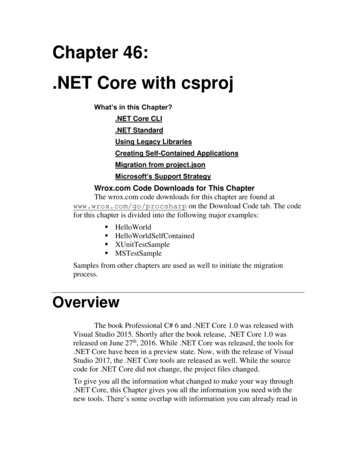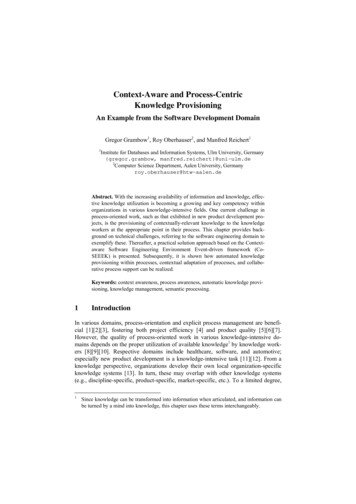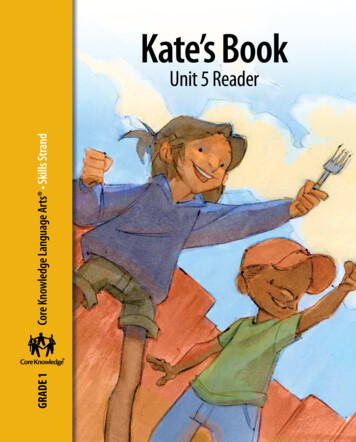
Transcription
Grade 1Core Knowledge Language Arts Skills StrandKate’s BookUnit 5 Reader
THIS BOOK IS THE PROPERTY OF:STATEBook No.PROVINCEEnter informationin spacesto the left asinstructed.COUNTYPARISHSCHOOL DISTRICTOTHERISSUED TOYearUsedCONDITIONISSUEDRETURNEDPUPILS to whom this textbook is issued must not write on any page or markany part of it in any way, consumable textbooks excepted.1. T eachers should see that the pupil’s name is clearly written in ink in thespaces above in every book issued.2. The following terms should be used in recording the condition of the book:New; Good; Fair; Poor; Bad.
Kate’s BookUnit 5 ReaderSkills StrandGrade 1Core Knowledge Language Arts
Creative Commons LicensingThis work is licensed under a Creative Commons AttributionNonCommercial-ShareAlike 3.0 Unported License.You are free:to Share — to copy, distribute and transmit the workto Remix — to adapt the workUnder the following conditions:Attribution — You must attribute the work in thefollowing manner:This work is based on an original work of the CoreKnowledge Foundation made available throughlicensing under a Creative Commons AttributionNonCommercial-ShareAlike 3.0 Unported License. Thisdoes not in any way imply that the Core KnowledgeFoundation endorses this work.Noncommercial — You may not use this work forcommercial purposes.Share Alike — If you alter, transform, or build upon thiswork, you may distribute the resulting work only underthe same or similar license to this one.With the understanding that:For any reuse or distribution, you must make clear toothers the license terms of this work. The best way todo this is with a link to this web 3.0/Copyright 2013 Core Knowledge Foundationwww.coreknowledge.orgAll Rights Reserved.Core Knowledge Language Arts, Listening & Learning,and Tell It Again! are trademarks of the Core KnowledgeFoundation.Trademarks and trade names are shown in this book strictlyfor illustrative and educational purposes and are the propertyof their respective owners. References herein should notbe regarded as affecting the validity of said trademarks andtrade names.
Table of ContentsKate’s BookUnit 5 ReaderA Letter from Kate. . . . . . . . . . . . . . . . . . . . . . . . . . . . . . 1In the Cave. . . . . . . . . . . . . . . . . . . . . . . . . . . . . . . . . . . . 2The Coin Shop. . . . . . . . . . . . . . . . . . . . . . . . . . . . . . . . . 8You Never Can Tell. . . . . . . . . . . . . . . . . . . . . . . . . . . . . 14The Offer. . . . . . . . . . . . . . . . . . . . . . . . . . . . . . . . . . . . 20The Campsite . . . . . . . . . . . . . . . . . . . . . . . . . . . . . . . . 22Jack’s Tale . . . . . . . . . . . . . . . . . . . . . . . . . . . . . . . . . . . 26The Visit . . . . . . . . . . . . . . . . . . . . . . . . . . . . . . . . . . . . . 32The Hike . . . . . . . . . . . . . . . . . . . . . . . . . . . . . . . . . . . . . 38The Bone Man . . . . . . . . . . . . . . . . . . . . . . . . . . . . . . . 46
Two Good Things and One Bad Thing . . . . . . . . . . 52The Big Dig . . . . . . . . . . . . . . . . . . . . . . . . . . . . . . . . . . . 56The Scoop . . . . . . . . . . . . . . . . . . . . . . . . . . . . . . . . . . . 62Pausing Point (Stories for Assessment and Enrichment)We Are TV Stars . . . . . . . . . . . . . . . . . . . . . . . . . . . . . . 70Nan’s Book . . . . . . . . . . . . . . . . . . . . . . . . . . . . . . . . . . . 74The Book Shop . . . . . . . . . . . . . . . . . . . . . . . . . . . . . . . . 78We Make a Book . . . . . . . . . . . . . . . . . . . . . . . . . . . . . 82
A Lett·er from KateI’m Kate Skipp·er, and this is my book!This book tells what I did last summ·erwhen I was nine. My mom and dad took meto vis·it with my Nan. Nan is my mom’s mom.She is an art·ist, and she has a cab·in out inthe West.At the start of my time with Nan, I wassad. It seemed like it would be a bor·ingsumm·er. But in the end I had a lot of fun.I made this book to tell you all the fun stuffI did last summ·er. When I fin·ished it, Nanmade the art. You have the book we made inyour hands. I hope you like it!Kate Skipper1
In the CaveWhen I went to vis·it with Nan, I was sad. Imissed Mom and Dad. But Nan cheered me upand made things fun.Nan took me on hikes. The land I saw inthe West was not at all like the land I am usedto. Where I am from, things are green in thesumm·er, and there are lots of trees. Out in theWest, there are hills and red rocks, but not a lotof trees. In some spots, you can hike for a mileand not see one tree!Once, Nan and I were on a hike when itstart·ed to storm. Nan and I went in·to a caveso that we would not get wet.2
3
As we were stand·ing there, I sawsome·thing shimm·er in the dark.“Nan,” I said, point·ing at the spot, “what’sthat?”“Well,” said Nan, “let’s have a look.”We looked and saw some·thing stuck in acrack in the rock. I grabbed it.“It’s a coin!” I said.“Well, I’ll be!” said Nan.4
5
I said, “What sort of coin is it?”Nan said, “I can’t tell. It looks like it could bemade of sil·ver.”Then she said, “I have a pal, Jack, who isan ex·pert on coins. We can bring it to himto·morr·ow, and he will tell us what sort of coinit is.”I dropped the coin in my pock·et, and wewent on with our hike.6
7
The Coin ShopNan drove us to the coin shop.The man in the coin shop was a pal of hers.His name was Jack.“Jack,” Nan said, “this is Kate Skipp·er. I’m Kate’snan. She’s out here for the summ·er. We went fora hike, and Kate found a coin in a cave.”“Well, Miss Skipp·er,” Jack said, “let’s have a lookat it!”I hand·ed him the coin.Jack set it un·der a look·ing glass andswitched on a lamp. “Let’s see,” he said. “It’s gotsome scratch·es on it. But I can tell that it’s aSpan·ish coin. It’s made of sil·ver, too.”8
9
“When was it made?” asked Nan.“There’s no date on the coin,” said Jack. “ButI’ll bet it dates back to the six·teen hun·dreds.The Span·ish mint·ed a big batch of coins likethis one back then.”“Good·ness!” said Nan.“Is that a long time back in the past?” Iasked.“Yes,” said Jack. “Let me run and fetch mybook on Span·ish coins.”When Jack came back, he said, “There’s justone thing I need you to tell me, Miss Skipp·er.”10
11
“What’s that?” I asked.“Are there a lot of coins like this one in thatcave?”“No,” I said, “we found just this one.”“That’s a shame,” Jack said.“Why?” I asked.“If there were a lot of coins, you and yourNan would be rich!” said Jack. “I could sell acoin like this for three hun·dred bucks!”“Three hun·dred bucks?” said Nan.Jack nodd·ed.“Yipp·ee!” I shout·ed. “I’m rich!”12
13
You Never Can TellJack said that he could sell the coin that Ifound for three hun·dred bucks. But I kept itand took it back to Nan’s cab·in.We got a snack from the kitch·en and thenstart·ed to chat.“Can I see the coin?” Nan asked.I stretched out my arm and gave it to her.“If this coin had lips,” Nan said, “what wouldit tell us? Would it tell us who left it in that caveand why he or she was there? What mag·ictale could it tell us?”“I wish it would,” I said. “What is the leg·endof this coin?14I stared at the coin for a bit.
15
“Could it be that a robb·er hid it there?” Iasked. “Did they have robb·ers back then?”“You bet they did,” said Nan. “But why wouldthe robb·er hide just one coin? It seems like hewould hide a large batch of coins.”“Per·haps he did not have a large batch,” Isaid. “Per·haps this was all he stole.”“If that’s all he stole,” said Nan, “then he wasnot such a good robb·er!”“Nan,” I said, “there’s no such thing as agood robb·er!”Nan smiled and nodd·ed.16
17
Af·ter a bit I said, “If this coin costs threehun·dred bucks, a robb·er would feel like hehad to hide it.”“Well,” Nan said. “Span·ish coins like this oneare rare, so Jack can sell them for a lot ofcash. But back when this coin was made, it wasnot rare. There were a lot of coins just like thisone. Back then this coin was sort of like a dime.”I took a dime out of my pock·et and said,“So if I keep this dime for a long time, un·til itgets rare and there are not a lot of them left,will it be a three hun·dred buck dime?”“It could happ·en,” said Nan. “You nev·er cantell!”18
19
The OfferI was sitt·ing in the kitch·en, scratch·ing alarge bug bite on my leg, when Nan came in.“I just spoke with Jack,” she said. “He madeus an off·er.”“What sort of off·er?”“He off·ered to take us camp·ing with himand Max.”“Who is Max?”“Max is nine, like you. Jack is his grand·dad.”“What would we do?” I asked.20
“Well, we would hike, look at rocks, cooklunch and dinn·er out·side, look at the stars, andsleep in a tent.”“Gee,” I said, “that sounds like fun! When canwe start?”“To·morr·ow morn·ing!” Nan said.21
The CampsiteJack came and picked us up in his truck. Wedrove to a camp·site in the Bad·lands.“Nan,” I said, “what’s up with that name—theBad·lands?”“Well,” said Nan, “leg·end has it that a longtime back, farm·ers came out here look·ingfor farm·land. When they saw all of the rocksand sand and stone, they said, ‘This is bad land!We can’t plant crops here!’ And the nameBad·lands just sort of stuck.”“It’s bad land for farm·ing,” said Jack. “But it’sgood land for camp·ing!”22
23
When we got to the camp·site, we hadto un·pack sleep·ing bags, tents, lan·terns,match·es, and lots of food. We lugged it all tothe camp·site.Jack chose a spot to set up camp. Max andI helped set up the tents. It took us a long time.For dinn·er we had hot dogs. We stuck themon sticks and held them in the fire. My hot doggot all black be·cau se I left it in there too long.Max gave me one of his.That was when I said to my·self, “Max is OK!”24
25
Jack’s TaleAf·ter dinn·er we munched on some gin·gersnaps. Then Jack shared an out·law tale.“This happ·ened out here in the West along time back,” said Jack, “in an age whenthere were no cars and no planes. Back then,if you had to send a lett·er, you sent it bystage·coach.”“The stage·coach was sort of like a car, butit was drawn by hors·es. There was a placewhere men could sit in·side. But the man whodrove the stage·coach sat out·side up on top.”26
27
“The man who drove the stage·coach keptthe strong·box next to him. The strong·box wasa locked box where he kept the cash.”“Some·times out·laws would rob thestage·coach. Those out·laws were bad men.But there was one who some said was a bitbett·er than the rest. His name was Bart.”“Bart was a sharp dress·er. He did hisrobb·ing in a jack·et and a black top hat. Hehad the best mann·ers you ev·er saw. When herobbed, he did not yell and shout at the menhe was robb·ing. Not Bart! He tipped his hat.”28
29
“Then he said, ‘Ex·cuse me, gents. Would yoube so fine as to pass down the strong·box withthe cash in it?’”“No!” said Nan.“Yes!” said Jack. “It’s not just a leg·end. It’s afact. You can look it up!”“Did they catch him?” Max asked.“Nope,” said Jack, “he came back androbbed the stage·coach lots of times.”“Did they ev·er catch him?” I asked.“Yes, af·ter a long hunt, they nabbed him.They charged him with theft and locked him upfor a long time. He did his time. Then they lethim back out.”“Then what happ·ened?” I asked.30
Jack said, “Bart shaped up in the end. Whenthey let him out, he said he was fin·ished withcrime.”“That’s cool!” said Max.31
The VisitAf·ter tell·ing us the tale, Jack said, “It’s timeto pack up the food.”We stuffed the food in·to a large pack with arope on it. Jack tossed the rope up in·to a treeand hoist·ed the food pack up so that it washang·ing ten feet off of the ground.“Paw-paw,” said Max, “why do we have tokeep the food up in the tree?”“Be·cau se it will keep the food safe fromfox·es and racc·oons that would like to snackon it,” Jack said.32
33
Af·ter that, we crawled in·to the tents,flipped off our lan·terns, and went to sleep.Nan and I slept well un·til a loud clatt·erout·side woke us up.“What was that?” I asked.“I can’t tell,” said Nan, as she hugged meclose to her.34
35
Jack ran out·side with his lan·tern and yelled,“Get out of here! Scram! Get lost!”When we went out, we saw Jack and Maxstand·ing there. Jack had his lan·tern.“Jack,” Nan asked, “who came to vis·it?”“I did not see it,” said Jack, “but I’m bett·ing itwas a fox who was look·ing for some scraps offood. He bumped in·to the pots and pans. Theclatt·er of the pots and pans must have scaredhim off.”“Is that why we hoist·ed the food pack up inthe tree?” Max asked.“That’s why!” said Jack.36
37
The HikeThe next morn·ing, we went on a hike. Af·tera bit, we stopped for lunch.When Max fin·ished his lunch, he asked, “CanKate and I look for rocks?”Jack said OK.“Kate,” Max said to me, “bring your fork. Wecan use it to dig up rocks.”I grabbed my fork, and we went off to lookfor rocks.38
39
Max point·ed at a bump on the side of a cliffand said, “Let’s dig that rock out!”The rock did not look all that large. But whenwe start·ed digg·ing, we soon saw that it waslarg·er than it had seemed.Af·ter a bit, Max said, “Gee! It must be twofeet long! We need to keep scratch·ing inor·der to carve it out of the side of the cliff.”We went on scratch·ing with our forks.“Let’s tug on it!” Max said. “I bet we can getit out by our·selves.”40
41
We grabbed and tugged it.It popped out. But so did a big cloud ofsand and dust. Max and I fell down.Once the dust and sand had drift·ed off, Isaw Max stand·ing there with the thing in hishands.“It’s not a rock!” he yelled. “It’s a bone!”It was the bigg·est bone I had ev·er seen. Itwas three feet long!42
43
Jack and Nan came runn·ing.“Good·ness!” said Nan. “That is one largebone! Where did you get it?”Max point·ed to the spot where we found it.Jack set the bone on the ground. Then hetook a pic·ture of the bone and said, “We needto get an ex·pert to look at this bone and tell uswhat sort of bone it is.”44
45
The Bone ManThe next morn·ing, Jack said, “I just had achat with a man from West·ern State Coll·ege.His name is Ron Fitch, and he is an ex·pert onbones. He has writt·en lots of books. If webring him the bone, he can tell us what sort ofbone it is.”“He’s a bone man?” asked Max.“Yep,” said Jack.We got in·to the truck. Jack said that I was incharge of the bone. I wrapped it up and set iton my lap.When we got to the coll·ege, we gave thebone man the bone. When he saw it, he brokein·to a big grin.46
47
The bone man bent down and said, “Icould be wrong, but it looks like you’ve foundsome·thing big here! I have to do some tests,but I’ll bet this is a bone of a T. rex.”“Sweet!” yelled Max.“What’s a T. rex?” I asked.Max looked at me like I was from Mars.“Kate!” he said, “T. rex is like the cool·est,bigg·est rep·tile of all time!”The bone man went and got a book. Hepoint·ed to a large pic·ture of a T. rex.48
49
“Jeep·ers,” I said, “he is big! Why have Inev·er seen a T. rex like this at the zoo?”The bone man smiled. So did Nan and Jack.“You can’t see a T. rex at the zoo,” the boneman said. “They were all wiped out a long timeback in the past. The T. rex is ex·tinct. All that’sleft of them to·day are bones pres·erved inthe ground. And there are not a lot of bones.That’s why it’s such a cool thing that you foundthis bone pres·erved in the side of the cliff!”50
51
Two Good Things and One Bad ThingThe next week, Nan said, “I just spoke withRon Fitch, the bone man. I’ve got three thingsto tell you. Two of them are good things thatyou will like. One is a bad thing that you will notlike.”“Tell me one of the good things,” I said.“Mis·ter Fitch got the tests back. The bonethat you and Max found is a T. rex bone!”“Yipp·ee!” I shout·ed. “I am glad that issolved. Max will be so thrilled that he has a T.rex bone!”“Well,” said Nan, “that brings me to the badthing.”52
53
“What is it?” I asked, scratch·ing my wrist.“The bad thing is that you and Max will notget to keep the bone for your·selves.”“Why not? Did we do some·thing wrong?”“Well,” Nan said, “it’s be·cau se you found thebone in a state park. There is a law that saysthat you can’t dig up bones in state parks andkeep them for your·self.”“Bumm ·er!” I said. “So who gets to keep it?”“The state. Mis·ter Fitch and his help·ers willkeep the bone and dig up the rest of thebones, too. And that brings me to the lastthing.”“This is a good thing?”54
“Yes.”“Tell me!”“They would like you and Max to vis·it themwhen they are digg·ing up the bones. And theywould like the two of you to pick out a namefor the T. rex that you found.”“Cool!” I said.55
The Big DigWhen we went back to the cliff, the boneman was there with some help·ers. They hadscraped the side of the cliff to ex·pose a lot ofthe T. rex.“So, will you dig out all of the bones here onsite?” asked Nan.“No,” said the bone man, “the next step willbe to carve this cliff in·to large blocks of rock.Then we will wrap the blocks up in plas·ter. Theplas·ter will keep the bones from crack·ing.Then we will use a large crane to set the blockson trucks. Then the trucks will take them to mylab. Once the blocks are there, we will startdigg·ing the bones out of the blocks.”56
57
“What sort of tools do you use for that?”asked Nan.“We use tools a lot like the ones den·tists useon teeth—brush·es and sharp picks.”“Kate and I used forks!” said Max.“How long will it take to carve all of thebones out of the rocks?” Jack asked.“Well,” said the bone man, “we’ve got a lot todo. It will take some time be·cau se we have tobe care·ful not to wreck the bones.”“Will you be fin·ished by the end of thesumm·er?” I asked.“No,” said the bone man, “you and Max willhave to vis·it next summ·er and per·haps thesumm·er af·ter that. Then we can catch up onour digg·ing prog·ress!”58
59
“So,” said the bone man, “have you pickedout a name for this T. rex?”“Yes, I’ve picked one,” I said.All of the digg·ers stopped digg·ing andlooked at me.I said, “This T. rex will be named Max, or ifyou like, T. Max!”All of the men cheered.Max smiled.60
61
The ScoopAf·ter we named the T. rex, some men camecharg·ing up to us.“Can we shoot some film of you for TV?”one of them asked. “It would be a big scoopfor us.”Nan and Jack said it was OK.62
63
The men set up a bunch of stuff to shootthe film. Then one of them start·ed count·ingdown from ten. He said, “Three, two, one!” Thenhe point·ed at us.The TV man spoke in·to a mike. He said, “Thisis Rog·er Fletch·er. I’m stand·ing here in theBad·lands, where two chil·dren have found thebones of a T. rex.”64
65
The man bent down to Max and stuck themike un·der his nose. He said, “What’s yourname?”Max looked like he was scared of the mike.He jumped back a bit. Then he mutt·ered, “I’mMax.”“And you?”I said, “I’m Kate.” Then I waved.“Max,” said the man, “where did you spot thebone?”Max said, “It was stick·ing out of the side of acliff.”66
67
“Kate, could you tell it was a bone when yousaw it?”“No,” I said, “it looked like a rock.”“What did you use to dig it out?”“We used our forks!” said Max.“Forks!” said the man. “That’s cool. CouldI get a close-up of the two of you with yourforks?”Some·one ran and got us two forks. We heldthem up and smiled un·til the man said, “Cut!”And that was the end of that.68
69
We Are TV StarsWe drove back to Nan’s cab·in and gotthere just in time to see our·selves on TV.The TV man said, “This is Rog·er Fletch·er.I’m stand·ing here in the Bad·lands, where twochildren have found the bones of a T. rex.”Then Max and I saw our·selves on TV.“Woo-hoo!” I shout·ed. “We are TV. stars!”Then came the part where the TV. manasked Max his name, and Max looked like hewas scared of the mike.“Max, you goof!” I said. “Why did you jumpback like that?”70Max just shrugged.
71
Next the TV man asked me my name.I said, “I’m Kate.” Then I waved.“Max,” said the TV man, “where did you spotthe bone?”Max said, “It was stick·ing out of the side of acliff.”“What did you use to dig it out?”“We used our forks!” said Max.Then we saw the close-up of Max and mewith our forks.“So there you have it!” said the TV man. “I’mRog·er Fletch·er with a tale of two chil·dren,two forks, and one large T. rex!”72
73
Nan’s BookMax and I and the T. rex were on TV sixtimes. I was glad when it came to an end.Af·ter you smile and wave a fork six times, itgets to be less fun.One morn·ing, Nan hand·ed me a book andsaid, “Let’s drive to the book shop.”“Nan,” I said, “why do you need to get abook at the book shop when you have thisone?”“I just fin·ished that one,” Nan said. “I liked ita lot. And it just so happ·ens that the man whowrote it will be at the book shop to·day. I’d liketo meet him.”74
75
In the car I looked at the book. It said “DustUp, by Stan Bend·er.”“What sort of book is this?” I asked.“It’s a west·ern,” said Nan.“What’s a west·ern?”“It’s a book set out here in the West.”“Is there an out·law in the book like Bart?”76
“There’s an out·law,” said Nan, “but he’s notlike Bart.”“Why not?”“He has bad mann·ers!” said Nan.I looked at the last page and saw the pagenum·ber: 305.“Yikes!” I said. “This is a long book!”“It is,” said Nan. “But it felt short to mebe·cau se I liked it so much. I was sad when Igot to the end!”I start·ed to look in·side the book, but justthen Nan said, “Here we are!”77
The Book ShopIn the book shop, there wasa big stack of books. Next to thebooks sat Stan Bend·er, the manwho wrote the books. He had apen in his hand and a big smileon his lips.“You’d smile too if your bookwere sell·ing as well as his is!”Nan said.Nan and I went and stood inline to meet Stan Bend·er.78
Nan shook hands with him and said, “I’ve gottwelve of your books. This one was your bestbook yet!”The man smiled and said, “That’s sweet ofyou! I hope you will pick up my next one, too!”“I will!” said Nan.Then the man wrote, “Best wish·es, StanBend·er,” in Nan’s book.“Mis·ter Bend·er,” I asked, “how hard was it towrite that book?”“Well,” he said, “this one was not all that hard.The last one I did was a lot hard·er.”As we got back in the car, I said, “Nan, I’dlike to write a book.”79
“What sort of book would it be?” Nan asked.“Well,” I said, “Max and I found the T. rex.”“Yes, you did,” said Nan.“And you and I found that coin.”“Yes,” said Nan.“And we are out here in the West.”“Yes.”“So it could be a bones and coins andwest·ern sort of book.”“Why not?” said Nan. “If you write it, I willmake the pic·tures.”I said, “Shake on it!” Then we shook hands.80
81
We Make a BookWhen we got back to Nan’s, I start·ed towrite the book. I wrote down all of the coolstuff that happ·ened to me out West. Thehard·est part was gett·ing start·ed. Once I gotstarted, it went fast.Nan helped me pick out good words.Some·times when you write, you have to writethings two or three times to get all of the bestwords and get them in the best or·der.Max helped me out, too. He said, “I canhelp you with spell·ing. I am the best spell·er inmy class.” Max looked at what I had writt·enand fixed a lot of spell·ing mis·takes that I hadmade.82
83
When I had writt·en the words, Nan got outher brush and start·ed to make the art. It tookher a long time. She sent the pic·tures to methree weeks af·ter I went home.My dad took me and my book to a pal of histo see if he would pub·lish the book.The man looked at it and said, “This is wellwritt·en! Chil·dren out there will like this book.I’d like to print it!”I was so glad, I shout·ed, “Yipp·ee!”84
85
The man and his staff got the book all set topub·lish. Then they sent it to a print·er.I hope you liked the book.If you’d like to write me a lett·er, you cansend it to me at this add·ress:Kate Skipperc/o Core Knowledge Foundation801 East High StreetCharlottesville, Virginia 2290286
87
About this BookThis book has been created for use by students learning to read with the CoreKnowledge Language Arts program. Readability levels are suitable for earlyreaders. The book has also been carefully leveled in terms of its “code load,” orthe number of spellings used in the stories.The English writing system is complex. It uses more than 200 spellings to standfor 40-odd sounds. Many sounds can be spelled several different ways, andmany spellings can be pronounced several different ways. This book has beendesigned to make early reading experiences simpler and more productive byusing a subset of the available spellings. It uses only spellings that studentshave been taught to sound out as part of their phonics lessons, plus a handfulof tricky words, which have also been deliberately introduced in the lessons.This means that the stories will be 100% decodable if they are assigned at theproper time.As the students move through the program, they learn new spellings andthe “code load” in the decodable readers increases gradually. The code loadgraphic on this page indicates the number of spellings students are expectedto know in order to read the first story of the book and the number of spellingsstudents are expected to know in order to read the final stories in the book. Thecolumns on the inside back cover list the specific spellings and tricky wordsstudents are expected to recognize at the beginning of this reader. The bulletsat the bottom of the inside back cover identify spellings, tricky words, and othertopics that are introduced gradually in the unit this reader accompanies.Visit us on the web at www.coreknowledge.org.
Core Knowledge Language ArtsSeries Editor-in-ChiefE. D. Hirsch, Jr.PresidentLinda BevilacquaEditorial StaffCarolyn Gosse, Senior Editor - PreschoolKhara Turnbull, Materials Development ManagerMichelle L. Warner, Senior Editor - Listening & LearningMick AndersonRobin BlackshireMaggie BuchananPaula CoynerSue FultonSara HuntErin KistRobin LueckeRosie McCormickCynthia PengLiz PettitEllen SadlerDeborah SamleyDiane Auger SmithSarah ZelinkeDesign and Graphics StaffScott Ritchie, Creative DirectorKim BerrallMichael DoneganLiza GreeneMatt LeechBridget MoriartyLauren PackConsulting Project Management ServicesScribeConcepts.comAdditional Consulting ServicesAng BlanchetteDorrit GreenCarolyn PinkertonAcknowledgmentsThese materials are the result of the work, advice, and encouragement of numerous individuals over many years. Some of those singled out here alreadyknow the depth of our gratitude; others may be surprised to find themselves thanked publicly for help they gave quietly and generously for the sake ofthe enterprise alone. To helpers named and unnamed we are deeply grateful.Contributors to Earlier Versions of these MaterialsSusan B. Albaugh, Kazuko Ashizawa, Nancy Braier, Kathryn M. Cummings, Michelle De Groot, Diana Espinal, Mary E. Forbes, Michael L. Ford,Ted Hirsch, Danielle Knecht, James K. Lee, Diane Henry Leipzig, Martha G. Mack, Liana Mahoney, Isabel McLean, Steve Morrison, Juliane K. Munson,Elizabeth B. Rasmussen, Laura Tortorelli, Rachael L. Shaw, Sivan B. Sherman, Miriam E. Vidaver, Catherine S. Whittington, Jeannette A. WilliamsWe would like to extend special recognition to Program Directors Matthew Davis and Souzanne Wright who were instrumental to the earlydevelopment of this program.SchoolsWe are truly grateful to the teachers, students, and administrators of the following schools for their willingness to field test these materials and fortheir invaluable advice: Capitol View Elementary, Challenge Foundation Academy (IN), Community Academy Public Charter School, Lake Lure ClassicalAcademy, Lepanto Elementary School, New Holland Core Knowledge Academy, Paramount School of Excellence, Pioneer Challenge FoundationAcademy, New York City PS 26R (The Carteret School), PS 30X (Wilton School), PS 50X (Clara Barton School), PS 96Q, PS 102X (Joseph O. Loretan),PS 104Q (The Bays Water), PS 214K (Michael Friedsam), PS 223Q (Lyndon B. Johnson School), PS 308K (Clara Cardwell), PS 333Q (Goldie Maple Academy),Sequoyah Elementary School, South Shore Charter Public School, Spartanburg Charter School, Steed Elementary School, Thomas Jefferson ClassicalAcademy, Three Oaks Elementary, West Manor Elementary.And a special thanks to the CKLA Pilot Coordinators Anita Henderson, Yasmin Lugo-Hernandez, and Susan Smith, whose suggestions and day-to-daysupport to teachers using these materials in their classrooms was critical.
CreditsEvery effort has been taken to trace and acknowledge copyrights. The editors tender their apologies for any accidental infringementwhere copyright has proved untraceable. They would be pleased to insert the appropriate acknowledgment in any subsequent editionof this publication. Trademarks and trade names are shown in this publication for illustrative purposes only and are the property of theirrespective owners. The references to trademarks and trade names given herein do not affect their validity.All photographs are used under license from Shutterstock, Inc. unless otherwise noted.WritersIllustratorsMatthew M. Davis, Mary E. MillerAll illustrations by Jacob Wyatt
Code Knowledge assumed at the beginning of the Reader:Vowel Sounds andSpellings:/i/ as in skim/e/ as in bed/a/ as in tap/u/ as in up/o/ as in flop (or paw)/ee/ as in bee/a e/ as in late/i e/ as in time/o e/ as in home/u e/ as in cute/oo/ as in soon/oo/ as in look/ou/ as in shout/oi/ as in oil/aw/ as in paw/ar/ as in car/or/ as in for/er/ as in herConsonant Soundsand Spellings:/p/ as in tip, tipping/b/ as in rub, rubbing/t/ as in bat, batting,asked/d/ as in bid, bidding,filled/k/ a s in cot, kid, roc
when I was nine . My mom and dad took me to vis·it with my Nan . Nan is my mom's mom . She is an art·ist, and she has a cab·in out in the West . At the start of my time with Nan, I was sad . It seemed like it would be a bor·ing summ·er . But in the end I had a lot of fun . Kate Skipper I made this book to tell you all the fun stuff
